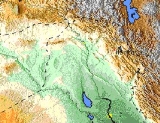
Armota
Encyclopedia

Assyrian people
The Assyrian people are a distinct ethnic group whose origins lie in ancient Mesopotamia...
village that is outside the town of Koy Sinjaq in the Iraq
Iraq
Iraq ; officially the Republic of Iraq is a country in Western Asia spanning most of the northwestern end of the Zagros mountain range, the eastern part of the Syrian Desert and the northern part of the Arabian Desert....
i governorate of Arbil. It is a two-hour drive from Sulaimaniyah. The name Armota comes from the Syriac language
Syriac language
Syriac is a dialect of Middle Aramaic that was once spoken across much of the Fertile Crescent. Having first appeared as a script in the 1st century AD after being spoken as an unwritten language for five centuries, Classical Syriac became a major literary language throughout the Middle East from...
, "Ar" meaning "land" and "mota" meaning "death"; hence "the land of death". The name origin comes from two theories; one being that a plague took over the village and killed all of its inhabitants. The other theory is that it was named after a fierce battle between the Assyrian Christians and the Islamic empire
Caliphate
The term caliphate, "dominion of a caliph " , refers to the first system of government established in Islam and represented the political unity of the Muslim Ummah...
, that left the village covered in blood (both of the events occurring in the 7th century.)
The village is a remote farming hamlet within a rural portion of northern Iraq that was declared a Kurdish-controlled zone
Iraqi Kurdistan
Iraqi Kurdistan or Kurdistan Region is an autonomous region of Iraq. It borders Iran to the east, Turkey to the north, Syria to the west and the rest of Iraq to the south. The regional capital is Arbil, known in Kurdish as Hewlêr...
after the Persian Gulf War
Gulf War
The Persian Gulf War , commonly referred to as simply the Gulf War, was a war waged by a U.N.-authorized coalition force from 34 nations led by the United States, against Iraq in response to Iraq's invasion and annexation of Kuwait.The war is also known under other names, such as the First Gulf...
.
A 4th century monastery sits on a hillside overlooking Armota. It has been built and destroyed many times. Most recently, Saddam Hussein
Saddam Hussein
Saddam Hussein Abd al-Majid al-Tikriti was the fifth President of Iraq, serving in this capacity from 16 July 1979 until 9 April 2003...
's soldiers used dynamite to blow it up in 1988. The monastery's destruction was part of a broad scorched-earth campaign targeting non-Arabs, dubbed the Anfal campaign.

